|
Luckyn Baronets
There have been two baronetcies created for persons with the surname Luckyn, both in the Baronetage of England. The Luckyn Baronetcy, of Little Waltham in the County of Essex, was created in the Baronetage of England on 2 March 1629 for William Luckyn. For more information on this creation, see the Earl of Verulam. The Luckyn Baronetcy, of Waltham in the County of Essex, was created in the Baronetage of England on 15 November 1661 for William Luckyn. The title became extinct on the death of the second Baronet in circa 1700. Luckyn baronets, of Little Waltham (1629) *see the Earl of Verulam Earl of Verulam is a title in the Peerage of the United Kingdom. It was created in 1815 for James Grimston, 4th Viscount Grimston. He was made Viscount Grimston (in the peerage of the United Kingdom) at the same time. Verulam had previously ... Luckyn baronets, of Waltham (1661) * Sir William Luckyn, 1st Baronet ( – ) * Sir William Luckyn, 2nd Baronet (died ) References *Kidd, Charl ... [...More Info...] [...Related Items...] OR: [Wikipedia] [Google] [Baidu] |
Baronetage Of England
Baronets are a rank in the British aristocracy. The current Baronetage of the United Kingdom has replaced the earlier but existing Baronetages of England, Nova Scotia, Ireland, and Great Britain. Baronetage of England (1611–1705) King James I created the hereditary Order of Baronets in England on 22 May 1611, for the settlement of Ireland. He offered the dignity to 200 gentlemen of good birth, with a clear estate of £1,000 a year, on condition that each one should pay a sum equivalent to three years' pay to 30 soldiers at 8d per day per man (total – £1,095) into the King's Exchequer. The Baronetage of England comprises all baronetcies created in the Kingdom of England before the Act of Union in 1707. In that year, the Baronetage of England and the Baronetage of Nova Scotia were replaced by the Baronetage of Great Britain. The extant baronetcies are listed below in order of precedence (i.e. date). All other baronetcies, including extinct, dormant (D), unproven (U), un ... [...More Info...] [...Related Items...] OR: [Wikipedia] [Google] [Baidu] |
Earl Of Verulam
Earl of Verulam is a title in the Peerage of the United Kingdom. It was created in 1815 for James Grimston, 4th Viscount Grimston. He was made Viscount Grimston (in the peerage of the United Kingdom) at the same time. Verulam had previously represented St Albans (Roman Verulamium) in the House of Commons. In 1808 he had also succeeded his maternal cousin as tenth Lord Forrester (in the Peerage of Scotland). He was succeeded by his son, the second Earl. Grimston was a Tory politician and held minor office in the first two governments of the Earl of Derby. His son, the third Earl, represented St Albans in Parliament as a Conservative. His grandson, the sixth Earl (who succeeded his elder brother) was nominated to the traditionally safe seat of St Albans for the party. the titles are held by his son, the seventh Earl, who succeeded in 1973. The titles of Viscount Grimston and Baron Dunboyne had been created in 1719 in the Peerage of Ireland for William Grimston, Member of Parl ... [...More Info...] [...Related Items...] OR: [Wikipedia] [Google] [Baidu] |
Sir William Luckyn, 1st Baronet
''Sir'' is a formal honorific address in English for men, derived from Sire in the High Middle Ages. Both are derived from the old French "Sieur" (Lord), brought to England by the French-speaking Normans, and which now exist in French only as part of "Monsieur", with the equivalent "My Lord" in English. Traditionally, as governed by law and custom, Sir is used for men titled as knights, often as members of orders of chivalry, as well as later applied to baronets and other offices. As the female equivalent for knighthood is damehood, the female equivalent term is typically Dame. The wife of a knight or baronet tends to be addressed as Lady, although a few exceptions and interchanges of these uses exist. Additionally, since the late modern period, Sir has been used as a respectful way to address a man of superior social status or military rank. Equivalent terms of address for women are Madam (shortened to Ma'am), in addition to social honorifics such as Mrs, Ms or Miss. Et ... [...More Info...] [...Related Items...] OR: [Wikipedia] [Google] [Baidu] |
Baronetcies In The Baronetage Of England
A baronet ( or ; abbreviated Bart or Bt) or the female equivalent, a baronetess (, , or ; abbreviation Btss), is the holder of a baronetcy, a hereditary title awarded by the British Crown. The title of baronet is mentioned as early as the 14th century, however in its current usage was created by James I of England in 1611 as a means of raising funds for the crown. A baronetcy is the only British hereditary honour that is not a peerage, with the exception of the Anglo-Irish Black Knights, White Knights, and Green Knights (of whom only the Green Knights are extant). A baronet is addressed as "Sir" (just as is a knight) or "Dame" in the case of a baronetess, but ranks above all knighthoods and damehoods in the order of precedence, except for the Order of the Garter, the Order of the Thistle, and the dormant Order of St Patrick. Baronets are conventionally seen to belong to the lesser nobility, even though William Thoms claims that: The precise quality of this dignity is no ... [...More Info...] [...Related Items...] OR: [Wikipedia] [Google] [Baidu] |


